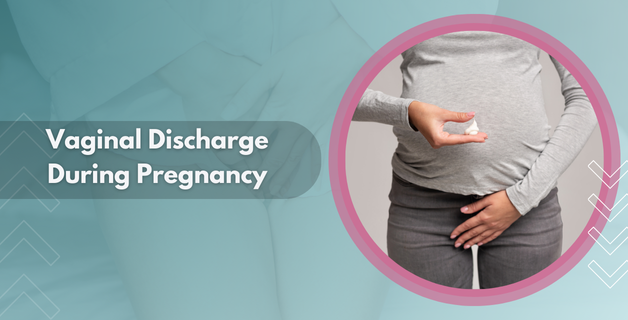Pregnancy brings about numerous changes in a woman’s body, one of the most common being vaginal discharge. While it is completely natural for discharge to increase during pregnancy, understanding what is normal and what is not can help alleviate concerns.
Dr. Himali Maniar, an experienced gynecologist in South Bopal, Ahmedabad, explains, “Pregnancy is a time when the body communicates through subtle signs. Understanding these signs helps mothers feel more confident and reassured during their journey.” Dr. Himali is an expert in managing high-risk pregnancies, gynecological concerns, and guiding women through every stage of reproductive health with compassionate care.
What is Vaginal Discharge?
Vaginal discharge is a fluid released from the vagina, composed of cervical secretions, old cells, and bacteria that help keep the reproductive system clean and healthy. In pregnancy, this discharge may increase due to hormonal changes and increased blood flow to the vaginal region.
It plays a protective role by flushing out bacteria, maintaining pH balance, and preventing infections from reaching the uterus.
Why Vaginal Discharge Changes During Pregnancy
Hormonal changes are the main cause of changes in vaginal discharge during pregnancy. The body undergoes an increase in estrogen, which stimulates the cervix and vaginal walls to produce more mucus. As a result, you may notice an increase in discharge, especially as the pregnancy progresses.
Additionally, increased blood flow to the pelvic area, a higher level of progesterone, and the growing size of the uterus all contribute to these changes. This is a protective mechanism for both the mother and the developing baby, keeping the vaginal area clean and reducing the risk of infections.
Types of Vaginal Discharge During Pregnancy
There are several types of vaginal discharge during pregnancy, each with its own significance:
- White vaginal discharge during pregnancy: Common and usually normal. Known as leukorrhea, it is thin, milky, and odorless.
- Vaginal discharge during early pregnancy: Often light, thin, and whitish, indicating normal hormonal changes.
- White vaginal discharge and itching: May suggest a yeast infection, especially if accompanied by burning or redness.
- Brown vaginal discharge during pregnancy: Could result from old blood being expelled. If it’s persistent or heavy, it may need medical evaluation.
- Yellow, green, or foul-smelling discharge: Often linked with infections and requires medical attention.
Recognizing the differences helps in knowing what’s normal and what’s concerning.
Vaginal Discharge in Each Trimester
First Trimester
During the early stages, increased discharge due to hormonal changes is very common. The discharge is typically thin, clear, or slightly milky and may have no noticeable odor. Early pregnancy discharge can also be accompanied by spotting, which is generally normal unless it is heavy or occurs with pain.
Second Trimester
As the pregnancy progresses, the amount of discharge usually increases and becomes thicker. It’s often white or milky, and some women might notice more frequent occurrences. This is usually a sign of a healthy pregnancy, but any changes in color or smell should be monitored closely.
Third Trimester
By the third trimester, the discharge tends to become more noticeable and thicker as the body prepares for labor. You may also notice an increase in mucus due to the growing size of the baby. In some cases, the discharge may contain bits of mucus or blood, which is an early sign of labor.
When to Seek Medical Help

While most discharge is harmless, consult a doctor if you notice:
- Strong odor or unusual color (yellow, green, or gray).
- White vaginal discharge and itching, burning, or swelling.
- Brown vaginal discharge during pregnancy that is heavy or persistent.
- Sudden watery discharge that may suggest ruptured membranes.
- Bloody discharge beyond light spotting.
Prompt medical evaluation ensures timely treatment and protection for both mother and baby.
Tips to Maintain Vaginal Health During Pregnancy

Dr. Himali Maniar, of Nisha Women’s Hospital, suggests the following tips to maintain vaginal health during pregnancy and minimize discomfort from vaginal discharge:
- Wear cotton underwear: Cotton fabrics allow better air circulation, reducing moisture buildup that can otherwise increase the risk of infections.
- Practice proper hygiene: Gently wash the vaginal area with mild soap and water. Avoid scented products that may irritate or disturb the natural balance.
- Stay hydrated: Drinking sufficient water keeps vaginal tissues healthy and lowers the chances of infection.
- Use pantyliners if needed: When discharge feels heavy, breathable pantyliners can help maintain comfort and hygiene.
- Consult a gynecologist regularly: Routine checkups during pregnancy are essential to ensure both maternal and fetal health remain on track.
Conclusion
Vaginal discharge during pregnancy is a common and normal occurrence, but understanding what changes are typical and when to seek help can make a significant difference in maintaining both maternal and fetal health. If you have concerns or notice any abnormal discharge, don’t hesitate to contact a trusted gynecologist. Early intervention and proper care will ensure a healthy pregnancy for you and your baby.





